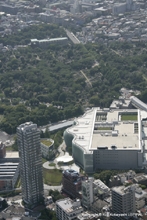




 |
Roppongi, Tokyo
Kisho Kurokawa architect & associates + Nihon Sekkei, Inc.
Design / Construction:2000-2006
Building Area: 12,989sqm
Total Floor Area: 49,846sqm
S Structure ( partly SRC Structure)
2 basement floors + 6 floors
The National Art Center, Tokyo is located in the Roppongi district at the center of Tokyo. Roppongi is a downtown area known for its numerous high-scale restaurants, boutiques, foreign offices in addition to being home to many ‘creators’.
The building is made up of seven enormous column-less display rooms, each 2000m², a library, an auditorium, a restaurant, a cafe and a museum shop. The floor area of the National Art Center, Tokyo totals 45,000m², making it Japan’s largest museum.
The National Art Center, Tokyo will not be a space for archiving works of art, but is a space for exhibiting public open exhibits and travelling exhibits. The largest exhibit in Japan, the Nitten Exhibition, supported by the Nitten Japan Fine Arts Group, displays a collection of over 12,000 works annually, taking up an area of 10,000m², or more than 5 display ‘blocks.’ The jurying process for these types of exhibitions will begin in the basement, where works will be brought in one by one at the loading area and only the pieces selected will be brought by service elevator to the display blocks. Medium and small sized public exhibits will most often be held in one ‘block’ and will be judged, separated, held and displayed as they are unloaded from trucks in the basement in a functional rhythm. One display ‘block’ can, moreover, be divided by partitions creating smaller spaces. This being the first super functional facility of its kind, it would be fair to call it a gigantic display machine. Designed to rival the mechanical display space is the atrium facade, an enormous transparent undulation. As the trees surrounding the museum grow, they will enclose the atrium in a forested public space. Also in the atrium space are two inverted cones, the upper portion of both featuring the restaurant and cafe. The atrium connects with the Roppongi downtown as one part of the street, perhaps to be an element of Roppongi’s famous nightlife .
* 2006 Chicago Athenaeum International Architecture Award
* 2008 Building Contractors Society Award
* 2008 Good Design Award |
|
